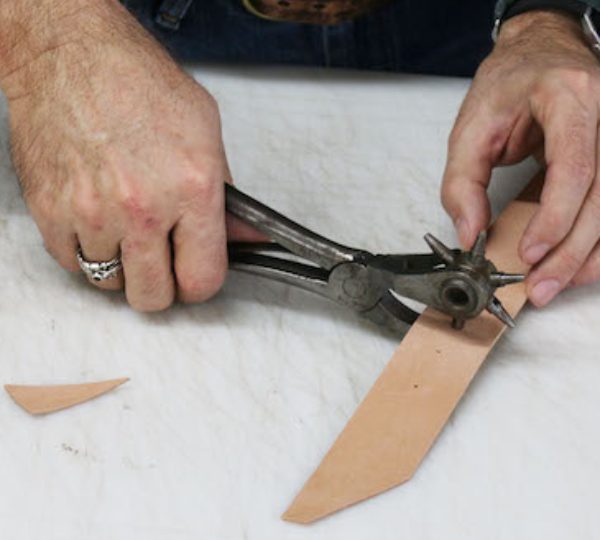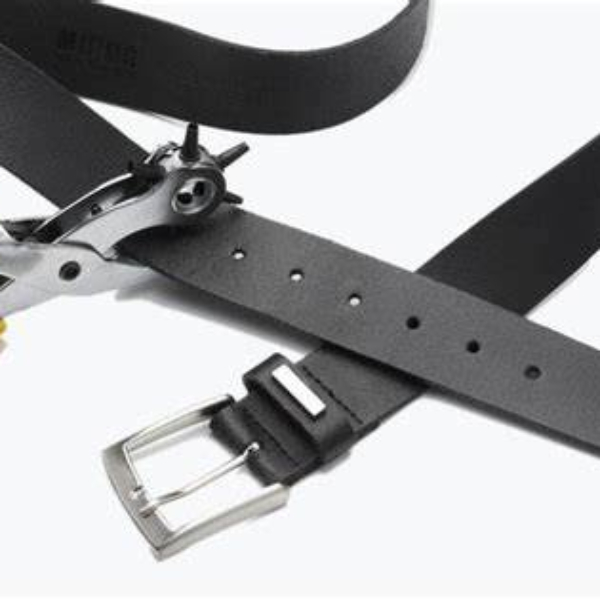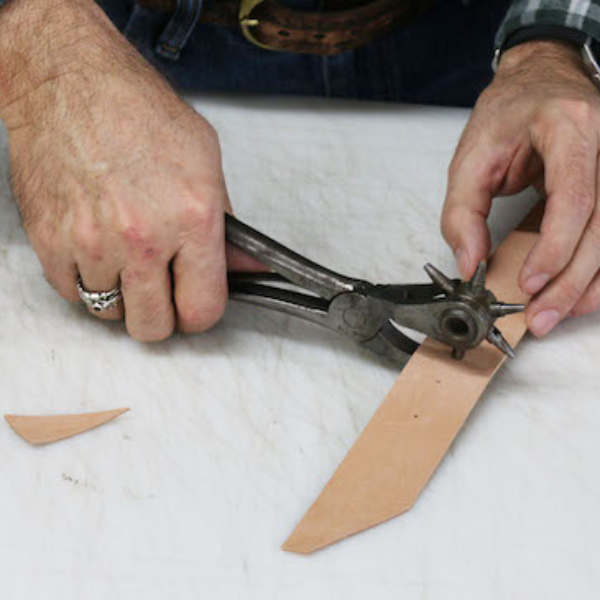
Guide to Adding Holes in Leather Belts
Essential Tools for Adding Holes in Belts
Adding a new hole to your leather belt need not be complex. However, the right tools can make the job easy and precise. In this section, we explore essential tools that simplify the process of making a hole in a belt.

The Rotary Punch
A rotary punch is a convenient and efficient tool for belt hole addition. It features multiple punch sizes in a single device. To use it, select the correct size, align it over your belt’s mark, and press the handles together. The result is a clean, round hole, perfect for your belt’s buckle.
The Round Drive Punch
For those who prefer manual tools, the round drive punch is ideal. This tool is a steel tube that comes in various sizes. Place the tool over your mark and hammer it to create a hole. The 3/16″ size is generally the right fit for most belts.
Preparing Your Belt for Drilling
Using a power drill can effectively create holes in your belt. First, equip your drill with a 3/16″ drill bit to ensure the right size. Next, you must hold the belt firmly while placing scrap wood beneath it. This step protects your work surface and provides stability. Always drill with care to prevent slipping, as this can cause damage. A slip can ruin the belt or lead to injury. Thus, prioritize safety as you start the drilling process. When creating holes in a coach men’s belt, ensure you use a 3/16″ drill bit for precision. Always prioritize safety to avoid damaging the belt during the process.
Precision and Technique Matters
Measuring and marking your belt accurately is essential before drilling holes. It helps avoid mistakes that could affect the belt’s usability. Each tool you use may require a steady hand and practice to achieve perfection. Therefore, take your time when drilling and focus on your technique. Frequent practice enhances your skills and builds confidence in your abilities.
Additionally, trying out various tools can lead to discovering the most efficient method for making holes. Remember, patience plays a vital role in achieving precise results. So, invest time in honing your techniques before committing to a final product. As you progress, the task will become second nature, and you will enjoy the satisfaction of a well-drilled belt.
Alternative Methods Without Specialized Tools
When specialized tools aren’t at hand, you can still make a hole in your belt.

Using a Pocket Knife
A small, sharp pocket knife can work well. Carefully pierce the leather, then twist the knife in a circular motion to enlarge the hole gradually.
Using a Scratch Awl
A scratch awl or a similar pointed tool can also start a hole. Push it through the mark and rotate to widen the hole to the right size.
Using a Nail
A common nail and hammer can begin the hole. Firmly hammer the nail through the belt. Then, round the hole with a knife for smooth edges.
These alternative methods require patience and care. Take your time to avoid mistakes and achieve a perfect round hole in your leather belt. Remember to work on a sturdy surface and to protect the belt from damage. Choose the method that best suits the tools you have, and create the additional belt hole you need.
Preparing the Belt for Hole Addition
Before you start making a hole in your leather belt, preparation is key.
Measuring and Marking the Belt
First things first, measure where you want your new hole. Use a ruler for accuracy. Mark the spot with a pen or marker. One inch apart is the standard for belt holes.
Ensuring Stability During the Process
Keep your belt stable while you work. Use clamps or hold it tightly against a solid surface. This prevents slips and ensures cleaner holes. Choose a well-lit space for safety and precision. Using the correct tools and a steady hand, you’ll add holes to your belt with ease.

Techniques to Achieve Perfect Holes
Achieving the perfect hole in a leather belt requires precision and the right technique. Here we’ll delve into methods that ensure your belt holes are both functional and aesthetically pleasing.
Drilling Properly Rounded Holes
To drill a properly rounded hole, choose a power drill with a 3/16″ bit. Before starting, ensure the belt is securely held and place a piece of scrap wood underneath. This prevents the belt from spinning or tearing. Carefully drill at the marked spot to create a neat, round hole. This method is straightforward and effective if done cautiously. When drilling a hole in a mens woven belt, make sure to use a piece of scrap wood underneath for stability. This ensures a clean and precise cut without damaging the belt.
Puncturing and Rounding Out Holes
Sometimes, you might not have a drill. In such cases, you can start a hole using a pocket knife or nail. First, puncture the leather at the marked point. Then, use a small sharp knife to carefully enlarge and round out the hole. Rotate the knife in the hole, gradually scraping out leather to achieve the desired size and shape. This method takes patience but can be highly effective in absence of specialized tools.
Preventative Measures to Avoid Damage
When adding holes to a leather belt, avoiding damage is crucial. Adopt these practices to ensure your belt remains in top condition.
Proper Placement of Support When Drilling or Punching
Always use a sturdy support beneath the belt while drilling. This support could be a piece of scrap wood. It prevents the drill bit or punch from damaging the surface below. Also, it stops the belt from moving or tearing during the process. Ensure the support is slightly larger than the belt for stable positioning.
Avoiding Common Mistakes
- Not Measuring Accurately: Measure twice before marking the belt. Use a ruler for precise marking.
- Using Dull Tools: Always check that your tools are sharp. Dull tools can tear the leather instead of cutting it cleanly.
- Rushing the Process: Take your time. Hurrying can lead to misalignment or incomplete cuts.
- Not Securing the Belt: Holding the belt firmly or clamping it down prevents slipping.
- Ignoring Safety Precautions: Always wear safety goggles to protect your eyes from flying leather bits.
Following these preventative measures can save your belt from damage while ensuring perfect new holes.
Choosing the Right Method Based on Available Tools
When you need to know how to make a hole in a belt, the tools you have can guide you to the best method. If you have specialized tools, like a rotary punch or a drill, your job could be quick and efficient. But don’t worry if you lack these tools. You can still achieve a good result with common household items.
- If you own a rotary punch, use it for precision and convenience. Align, squeeze, and you have a perfect hole.
- With a round drive punch and a hammer, you can punch through the leather with control.
- A power drill offers a fast way to create holes—just ensure you drill safely with proper backing.
Without these specialized tools, you can use alternative methods:
- A pocket knife can start your hole, then twist to enlarge it to the right size.
- A scratch awl can perforate the belt, use it to push then rotate to widen the hole.
- A nail can be hammered through the leather with the belt on scrap wood, finishing with a knife.
Choosing the right method depends on what tools are available and the amount of care you can apply. Use patience and steadiness, regardless of your choice. And always measure and mark carefully before making the hole. Each approach has its own technique, so select one that you feel comfortable with and that aligns with the tools at your disposal. When determining belt size, consider the tools and methods at hand. Patience and careful measurement are key to ensuring a proper fit.